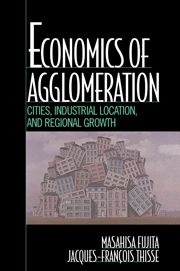Book contents
- Frontmatter
- Contents
- Acknowledgments
- 1 Agglomeration and Economic Theory
- PART I FUNDAMENTALS OF GEOGRAPHICAL ECONOMICS
- PART II THE STRUCTURE OF METROPOLITAN AREAS
- 6 The Spatial Structure of Cities under Communications Externalities
- 7 The Formation of Urban Centers under Imperfect Competition
- PART III FACTOR MOBILITY AND INDUSTRIAL LOCATION
- PART IV URBAN SYSTEMS AND REGIONAL GROWTH
- References
- Name Index
- Subject Index
6 - The Spatial Structure of Cities under Communications Externalities
Published online by Cambridge University Press: 05 June 2012
- Frontmatter
- Contents
- Acknowledgments
- 1 Agglomeration and Economic Theory
- PART I FUNDAMENTALS OF GEOGRAPHICAL ECONOMICS
- PART II THE STRUCTURE OF METROPOLITAN AREAS
- 6 The Spatial Structure of Cities under Communications Externalities
- 7 The Formation of Urban Centers under Imperfect Competition
- PART III FACTOR MOBILITY AND INDUSTRIAL LOCATION
- PART IV URBAN SYSTEMS AND REGIONAL GROWTH
- References
- Name Index
- Subject Index
Summary
INTRODUCTION
The most distinctive feature of a city is its much higher population density than the surrounding nonurban areas. As a result, economic agents residing within a city are close to one another. But why do households and firms seek spatial proximity? Fundamentally, this occurs because economic agents need to interact and distance is an impediment to interaction. This need is gravitational in that its intensity is likely to increase with the number of agents set up in each location and to decrease with the distance between two locations. This need has been at the heart of the work of several geographers, and we will encounter it on many occasions and with different economic meanings.
However, by crowding a few locations only, economic agents also decrease their satisfaction because they normally enjoy consuming more land, either as consumers or as producers. Therefore, one can view the agglomeration process, at least in the first order, as the interplay between an interaction field among agents and competition on the land market. In such a setting, the need to interact acts as a centripetal force, whereas competition for land has the nature of a centrifugal force. As will be seen in this chapter, it is remarkable that the mere need to interact turns out to be sufficient to generate a single-peaked distribution of (homogeneous) agents across locations.
But this is not the end of the story. Indeed, one has to explain why economic agents want to interact? It should be clear that several explanations can be put forward.
- Type
- Chapter
- Information
- Economics of AgglomerationCities, Industrial Location, and Regional Growth, pp. 169 - 216Publisher: Cambridge University PressPrint publication year: 2002



